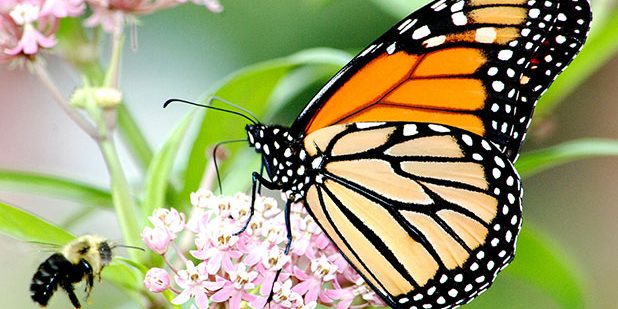Monarch butterfly on swamp milkweed in Michigan. Photo by Jim Hudgins/USFWS.
Efforts to stem the decline of monarch butterflies took a giant leap forward today with the completion of a historic agreement between the U.S. Fish and Wildlife Service and the University of Illinois-Chicago. The agreement encourages transportation and energy partners to participate in monarch conservation by providing and maintaining habitat on potentially millions of acres of rights-of-way and associated lands.
Thanks to the monarch agreement, more than 45 companies in the energy and transportation sectors and countless private landowners will provide habitat for the species along energy and transportation rights-of-way corridors on public and private lands across the country. Participants will carry out conservation measures to reduce or remove threats to the species and create and maintain habitat annually. Although this agreement specifically focuses on monarch habitat, the conservation measures will also benefit several other species, especially pollinating insects.
“Completing this agreement is a huge boost for the conservation of monarch butterflies and other pollinators on a landscape scale,” said Aurelia Skipwith, Director of the U.S. Fish and Wildlife Service. “This is a great example of how the Trump administration is working proactively with our partners in the energy, transportation and agriculture industries to provide regulatory certainty for industry while addressing the conservation needs of our most at-risk species.”
Monarch butterflies and other pollinators are declining due to multiple factors, including habitat loss. Agreements like this offer an innovative way for partners to voluntarily help at-risk species while receiving regulatory assurance and predictability under the Endangered Species Act (ESA). The Service is currently evaluating the monarch to determine whether listing under the act is appropriate.
“Restoring this species cannot be done by the federal government alone; cooperation is key. This agreement is essential to ensuring that private landowners embrace practices to protect and preserve monarch butterflies, and those private landowners will benefit from regulatory certainty in return. It’s a true win-win,” said U.S. Senator Tom Carper. “I am proud that my state of Delaware is engaged in this effort, and I want to thank the CCAA participants for driving this agreement forward and seeing it through to finalization. It’s my hope that, by working together, we can bring monarch butterflies back from brink of extinction.”
“By engaging early in voluntary conservation, utilities and departments of transportation can avoid increased costs and operational delays as a result of a potential listing. This provides tremendous value to industry and will also yield big benefits to the monarch butterfly,” said Iris Caldwell, program manager of the University of Illinois-Chicago’s Energy Resources Center, which will administer the agreement. “Not only is this the largest CCAA in history and completed on one of the fastest timelines thanks to our incredible partners, but it also represents an extraordinary collaboration between industry leaders and the U.S. Fish and Wildlife Service that can serve as a model for addressing challenges to other at-risk species.”
“The American Farm Bureau Federation (AFBF) applauds the work of the U.S. Fish and Wildlife Service and the participating energy and transportation organizations to conserve the monarch butterfly across the landscape,” said Zippy Duvall, President of the American Farm Bureau Federation. “AFBF appreciates the efforts of Director Skipwith and her staff for their coordination with farmers and ranchers to develop this important conservation tool. This agreement brings greater certainty to those who manage lands in and near rights-of-way while providing essential habitat for the monarch and other pollinators.”
“The signing of this CCAA for monarch butterflies is the culmination of a great deal of work by an amazing public-private partnership, including utilities, state department of transportation and the U.S. Fish and Wildlife Service,” said Brian Kortum, director of environmental planning for NiSource. “We are excited by the opportunity this presents NiSource to do our part for monarch butterfly conservation while providing flexibility to our company operations.”
The Service and the University of Illinois-Chicago signed an integrated, nationwide Candidate Conservation Agreement (CCA) and Candidate Conservation Agreement with Assurances (CCAA) for the monarch butterfly on energy and transportation lands throughout the lower 48 states.
CCAAs and CCAs are formal, voluntary agreements between the Service and landowners to conserve habitats that benefit at-risk species. A CCAA is for non-federal partners only and provides assurances to participants (in the form of an “enhancement of survival permit”) that no additional conservation measures will be required of them if the covered species later becomes listed under the ESA. A CCA can be entered into by any partner, whether federal, state or local authority, NGO or private individual or corporation. It memorializes the conservation commitment of the landowners, but unlike a CCAA, it does not provide assurances.
The monarch agreement integrates both CCA and CCAA programs so energy and transportation partners and private landowners can provide conservation seamlessly throughout their properties, where there may be a mix of non-federal and federal lands.
In addition, if monarch butterflies are listed as endangered or threatened in the future, the Service would grant permission for “incidental take” (a term under the ESA) to partners enrolled in the agreement. Incidental take includes the unintentional harming, harassing or killing of a listed species and is prohibited under the ESA unless a permit is issued.
The Service was petitioned to list the monarch butterfly under the Endangered Species Act in 2014 and is required to make a determination on whether a listing is warranted in December 2020.
More information regarding the Service’s monarch butterfly conservation efforts and the candidate conservation agreement with assurances can be found on the Service’s Save the Monarch website.






